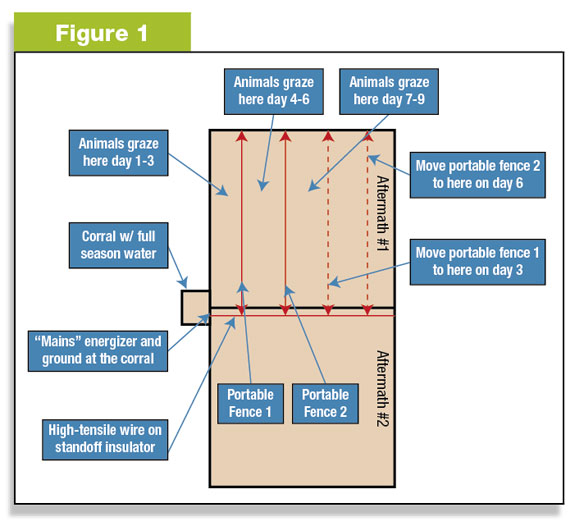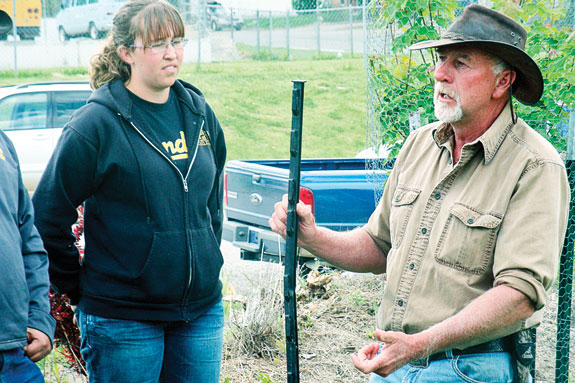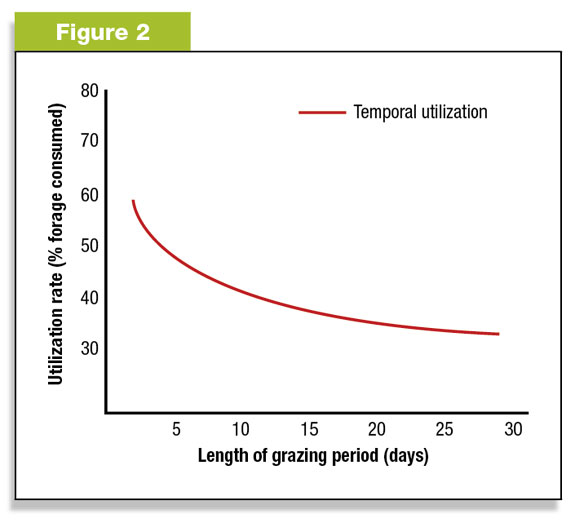In south-central Idaho, hay aftermath usually lasts about 30 days. Last year stock cow hay was at least $180 per ton, so if an operator could get another 30 days out of the same aftermath, and maintain the feed quality, it would be worth about $2.16 per day or about $65 per cow.
Late fall and early winter are a great time for dry, spring-calving cows to be on lower-quality forages because their energy and protein demands are lower in the first and second trimesters of pregnancy.
It can also be a good time to put some inexpensive growth on those calves that were just weaned if some “calf feed” is available.
The allocation and appropriate use of aftermath forages is a good way to extend the grazing season, maintain feed quality and keep the cows out of the haystack. Here is how and why.
Most cows have a job description that includes, ”Get the best bite possible,” and that is exactly what they do. Cows are binge feeders.
They eat all the best bites until they cannot eat anymore; rest, defecate, wander around, tread on feed, pack snow into ice and return to eat all they can again. Cows don’t plan. They just eat all the best feed they can today.

After each grazing episode, the pasture or aftermath has less feed on offer, of a lower quality, and the cows may have eaten more than they need.
Low quantity and quality result in progressively declining feed intake of lower forage quality, reduced animal performance, and cows that run out of feed faster than necessary.
The next thing you know, you have the cow welfare wagon out and you are into the haystack.
Research at the University of Missouri Forage Research Center, and at other locations, demonstrates that cows or calves experiencing grazing periods of 25 or more days often harvest less than 30 percent of the available feed.
Reducing the grazing period to three days can increase harvesting efficiency to 55 to 60 percent. One-day grazing periods can result in harvesting efficiencies as high as 70 percent or higher.
This happens when feed is allocated to the animals to meet their needs and they are not permitted to degrade the balance of the feed resource. Making use of proper feed allocation is the key to getting more out of your aftermath.
Quality equipment
The easiest way to allocate your crop aftermath is using high-quality portable electric fence materials, which will permit you to allocate new feed every one to three days with the least fuss and highest efficiency possible. For most applications a single strand of poly-wire is adequate.
Select a portable or “mains” energizer that will provide at least 1 joule per mile of fence. Provide adequate grounding for your equipment.
The number one cause of poor performance by electric fencing is poor grounding of the energizer. Use the number of ground rods recommended and check the effectiveness with your volt meter.
Use the best-quality poly-wire or tape available. Poly-tape is more visible to wildlife but is heavier and will be a burden if it is not needed.
Select a high-quality multiplier reel holding one-quarter mile of poly-wire. Larger reels are available but are heavy and unwieldy.
You will need plastic tread-in posts with a small diameter high-tensile steel spikes and foot treads big enough to get your foot on.
Invest in a digital volt meter or “fence compass,” which will make it easy to keep your fence working properly.
Poor-quality equipment results in poor performance, frustration and disenchantment. In some cases, or in the future, you may elect to install some permanent high-tensile electric fence on stand-off insulators along one side of your fields to make it easier to string your poly-wire.
Train your livestock
A single strand of poly-wire is not a physical barrier to a 1,200-pound cow. It is the fear of the consequence of touching the poly-wire that keeps the cows in.
If your animals are routinely exposed to electric fence, they probably are already trained. If not, do not short-cut this step.
Put up some temporary electric fence in a corral about three to six feet from the hard fence. Make sure there is at least 5,000 KV on the poly-wire.
Scatter a little hay around the corral, especially the space between the poly-wire and the hard fence and turn the “trainees” in.
In three to four hours, or overnight, every animal will understand the electric fence. A “refresher” for cows that have been away all summer on range is not a bad idea.
If you plan to introduce additional animals into the herd, be sure they are trained first. If after training the cows, you find one or two that are incorrigible about either jumping or tearing down the fence, you will have to decide if you are going to “fire” them or continue to let the cows make your management decisions for you.

Energized fences
Keep all the poly-wire that is deployed up to voltage. Wildlife will learn to respect even temporary fences if they are kept energized, and cattle will learn to not “test” every fence. This also keeps calves and rodents from chewing up your poly-wire.
Snow, particularly bitterly cold snow, is a very poor conductor. Test your fence with the digital volt meter by dropping the ground lead on the ground and stepping on it while you hold the other meter lead on the fence.
This will tell you what the animals will “see” when they touch the fence. A “fence compass” does not require a ground lead and it may read significantly higher voltages than an animal will experience when the weather is very cold.
If you reach a point where you are reading less than 2,500 KV on the fence because of the snow and cold, consider adding a second poly-wire to your fence that is grounded. This probably will not happen in the fall, but it may when it gets cold.
Back-fencing, which is required to protect pasture regrowth, is not required in allocating aftermath because there is no re-growth.
Stock water is also easier to deal with. Start allocating forage near the permanent or other winter water source and the animals can return as far as necessary, because there is no back-fencing.

An easy half hour
Allocating aftermath is also a great way to learn to estimate the amount of feed to offer, because you generally cannot hurt the livestock or the pasture from overuse or under- allocation.
If you have come this far, your final objection may be: “It takes too long!” Moving a quarter-mile of poly-wire with good-quality tread-in posts should take you less than 30 minutes.
If you use two fences, you will simply take down the fence closest to the cattle and let them into the next break, then go around and fence off the break for the next day.
I doubt that many can feed hay in less than 30 minutes a day, which means more time to visit at the round table or enjoy the fire.
Even if hay is $50 a ton this fall, you can actually save time and money by allocating your fall feed rather than throwing all the gates open. Try it – you have everything to gain. ![]()
Learn more about management-intensive grazing at the University of Idaho Extension, Lost Rivers Grazing Academy, September 11-14 near Salmon, Idaho. For information, contact Charles Cheyney, (208) 527-8587 or ccheyney@uidaho.edu, or Scott Jensen, (208) 896-4104 or scottj@uidaho.edu. Get a registration form at http://www.extension.uidaho.edu/owyhee/AgLostRiversGrazingAcademy.htm and follow us on Facebook at http://www.facebook.com/LostRiversGrazingAcademy.
PHOTOS
TOP: Moving cows to fresh aftermath in November in the Pahsimeroi Valley of Idaho.
MIDDLE: Graphic showing a way to utilize aftermath adjacent to a corral with full season water supply. Cattle advance away from water to the next strip every 3 days and return to the corral for water. When cattle are turned into the next strip, the portable fence is “leap-frogged” ahead, so that it will be ready. Assuming that there is electricity at the corral, a “mains” energizer and grounding system, a single, permanent high-tensile wire is place on the fence between the field to serve both fields.
BOTTOM: Not all “tread-in” posts are created equal. Jim Gerrish discusses the features of tread-in posts at the Lost Rivers Grazing Academy. Photos courtesy of Dawn Gerrish, American GrazingLands Services LLC and Charles Cheyney.
Charles Cheyney
Extension Educator
University of Idaho
ccheyney@uidaho.edu







